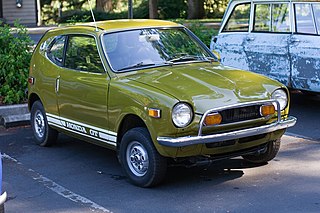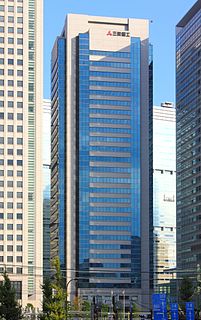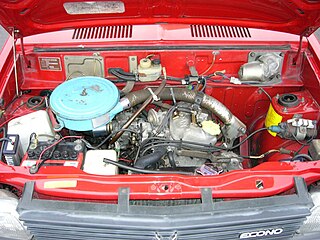
The Mazda Carol is a name that was used by Suzuki for Mazda for its kei cars from 1962 until 1970. It was revived again with Mazda's 1989 re-entry into the kei car class with the Autozam brand. Since then, it has been related to the Japanese Suzuki Alto.
The Mazda Porter and Porter Cab are a series of small trucks that were produced from 1961 to 1989 by Mazda, mainly for sale in the domestic Japanese market. Export versions of the Porter were labelled E360. The Porter was replaced by the Autozam Scrum, a rebadged Suzuki Carry.

The Mazda Chantez is a two-door kei car that was introduced by Mazda in July 1972. The Chantez had a longer wheelbase at 2,200 mm (86.6 in) than most of its competitors and featured the powerful two-stroke "AA" engine also seen in the Porter. With 35 PS, top speed was 115 km/h (71 mph) and the 400 m (0.2 mi) sprint was dispatched in a sprightly 20.6 seconds. In more recent testing of a 1972 GF II, 0–100 km/h came up in 35.8 seconds. The engine was installed longitudinally powering the rear wheels, and the spare tire was installed next to the engine on the right side.

The Daihatsu Fellow Max is a small Japanese automobile in the Kei car class. Originally introduced as the Daihatsu Fellow, the name was partially retained for the Max Cuore (1977) and then again for the 2000 Daihatsu Max.

The Mitsubishi Pajero Mini is a kei car produced by Mitsubishi Motors from December 1994 until June 2012.
This is a list of engines produced by Mitsubishi Motors since 1964, and its predecessors prior to this.

The Honda Z is a two-door hatchback kei car/city car manufactured and marketed by the Honda Motor Company, from 1970 until 1974. Exports mostly ended after 1972, when the domestic market models received redesigned pillarless bodywork.

The Suzuki Fronte is an automobile that was first introduced in March 1962 as a sedan version of the Suzulight Van. The nameplate remained in use for Suzuki's Kei car sedans as well as some other commercial-use vehicles until it was replaced by the Alto name in September 1988.

The Honda N360 is a small front-engine, front-wheel drive, two-passenger two-box automobile manufactured and marketed by Honda from March 1967 through 1970 in compliance with Japan's kei car regulations.

The Subaru Sambar is a cabover kei truck and microvan manufactured by Subaru, a division of Fuji Heavy Industries, specifically for the Japanese market. It is Japan's first Keitora (軽トラ), shorthand for "kei class truck" and is still in production. The Sambar is available in both microvan and Kei truck to fulfill the Kei car guidelines. Still popular in the domestic market, the Sambar continues to be produced in Japan, China as well as in Finland with a joint venture with Elcat Automotive.
The Mitsubishi Mizushima is the first of a series of three-wheeled cargo carriers made in Japan by Mitsubishi between 1946 and 1962. It was a mechanically simple and rugged vehicle, with a 400 kg carrying capacity, and was equipped with a folding canvas covering and a windshield to protect the occupants. Along with the Silver Pigeon scooter it represented the company's first contributions to the Japanese post-war personal transport boom.

Suzulight was the brand used for the kei cars built by the Suzuki Motor Corporation from 1955 to 1969. They were Suzuki's first entry into automotive manufacturing, having previously only produced motorcycles. The Suzulight sedans and light vans all had transversely mounted engines and front-wheel drive. The Suzulight Carry trucks and vans were the first to use the Carry label, still around today.
LC10 was the original name given to a series of very small three-cylinder, two-stroke engines built by Suzuki Motor Corporation in the 1960s and 1970s. They were used in a number of kei class automobiles and light trucks. The LC10 and its derivatives did not completely replace the FE and L50 two-cylinders, which continued to be used mainly for light commercials. The LC10 engine was developed together with the Suzuki B100 engine, a 8–11 PS (5.9–8.1 kW) 118.9 cc single-cylinder motorcycle engine which shared the same bore and stroke. For longevity and convenience, the LC10 received Suzuki's new "Posi-Force" auto-lubrication system, eliminating the need for pre-mixed fuel.

The Suzuki FB engine is a series of two- and three-cylinder two-stroke engines that was produced by the Suzuki Motor Corporation from October 1961 until November 1987. They were used in a number of Kei-class automobiles and light trucks. From the original air-cooled 359 cc straight-twin version the FB series developed through a number of different models having different names, ending with the water-cooled, three-cylinder LJ50. The names used for various versions of this engine often refer to the chassis code of the cars in which they were introduced, until Suzuki changed their engine naming system sometime in the first half of the 1970s.


















